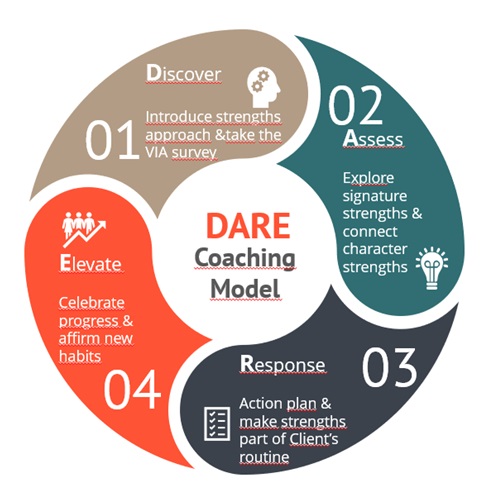A Coaching Model By Anita Szabo, Leadership & Career Coach, HUNGARY

DARE Model
It means having the courage or boldness for something or being bold enough.
As a leadership coach, I created the DARE model specifically for leaders looking to grow and develop their leadership skills, regardless of their leadership seniority. In most cases, their employer sponsors a 12-sessions leadership coaching program with pre-defined goals in a three-way agreement.
This model aims to boost empowerment by applying the VIA structure with character strengths, helping clients achieve their goals.
Why Is Being Empowered So Important?
Empowerment is the degree of autonomy and self-determination in people and communities. It is the process of becoming stronger and more confident, especially in controlling one’s life and claiming one’s rights. Empowerment as action refers both to the process of self-empowerment and to the professional support of people, which enables them to overcome their sense of powerlessness and lack of influence and to recognize and use their resources.
And what could be a better resource than their own strengths? The strength-based approach known as the “empowerment circle” has become an instrument of organizational development.
Introduction to Character Strengths
Throughout my career, I often faced the challenge that the feedback and performance evaluation processes are very deficit-based.
A central attribute of a strengths-based approach is that it either necessarily complements a deficit-based approach or provides clients with an effective alternative that some will view as especially beneficial and refreshing.
The study of strengths started in the early 20th century when scientists gathered to study character more scientifically.
The result was the VIA Classification of Character and Virtues (Peterson & Seligman, 2004), a classification of positive traits in human beings. After completing the VIA classification, a ground-breaking personal strengths test, the VIA Survey has been designed to measure the 24 character strengths in individuals.
Character strengths are the positive parts of our personality, impacting how we think, feel, and behave. Knowing and applying our highest character strengths helps us to become our best-self.
The Process: How to Use the Model
Before applying the model, a joint conversation happens with the Sponsor and Client to align on the goals of the coaching program. The three-way conversation elicits a commitment from the client to play their part in their development and from their manager to support them in the process.

1st Step: Discover: Introducing the Strengths Approach, the Client Takes the VIA Survey
This step of the model is applied only during the first session with the Client. The starting point of the coaching session will be to identify and understand the subject and context of the discussion.
The Coach checks the Client’s engagement, reconfirming the targets and determining the desired outcome. It should be concluded whether the client has the emotional motivation to achieve any of the goals previously discussed.
Trying to see the Client’s goal from a broader view. Understand the meaning of their purpose, its importance, and what specifically its meaning is for them. Perception refers to understanding the broader context of the Client’s situation and goals – how it will impact the grand scheme of things, how it will impact other people’s emotions and goals, and how it will open doors for the next stage of progress.
Before giving the homework to the Client to make their VIA strength survey, the Coach provides an introduction to character strengths, highlighting the meaning and importance of signature strengths. Including the rationale for using a strengths-based approach and linking it to their problems or goals. This can educate the client, build awareness of their strengths, and contribute to “client buy-in” for the strengths-based approach.

VIA Classification Hierarchy in Character Strengths and Virtues (2004).
Example questions:
- What is your level of engagement toward your coaching program?
- How much do you want your goal – on a scale of 1 to 10?
- How motivated are you to reach this goal?
- What is it exactly excites you about this goal?
- What would make you more motivated?
- If you achieve your goal – how will you feel? How will it look?
- How will you know when you have achieved your goals?
- Is there an area you would like to focus on?
- What are your long-term goals?
2nd STEP: Assess: Exploring Signature Strengths, Connecting Character Strengths
This phase moves from general awareness of the strength to deeper insights.
Once the Client’s perspective has been opened to the broader picture, it is much simpler to explore the various options available to the individual working with their strength and helping the client to confirm their signature strengths, supporting them to draw connections between their words and behaviors.
This phase involves:
- Connecting character strengths, mainly those highest in their profile, with their past successes, relationships, and moments when they were happiest or faced challenges.
- Digging deeper into connections between strengths and the Client’s past, present, and future
Coach might give homework to Client: remembering times when Client was at their best, spotting the strength in play.
Example questions:
- What is your first reaction to seeing your survey results?
- What surprises you most about your VIA results?
- What are the pluses and minuses of working on your character strengths?
- Do the highest strengths resonate for you as signature strengths?
- Do you feel the top strengths are the most core to who you are and most energizing and natural for you to use?
- How could you play to your strengths?
- What choices are you currently making? What other choices are there?
- What are your impacts on other people?
- What are future consequences?
- When you consider times when you were successful, what strengths were you using?
- How did each of your signature strengths come into play?
- How do you express each of your signature strengths every day?
- When you think of a time when you were anxious, depressed, or highly stressed, which strengths did you lean on to move forward?
- Consider your past or current mentors (or role models). What strengths did they embody?
- How did they express them? What strengths did they see in you?
3rd Step: Response: Action Planning: Making Strengths Part of the Client’s Routine
The aim is that the Client will leave the coaching session with an idea of their current situation, long and mid-term goals, the effect of their own emotions on motivation and how to improve their drive, a greater perception of their actions on themselves, and the world around them, and a carefully devised plan of action with clearly defined steps and measurable goals. This should allow them to retain their motivation throughout a manageable process toward their long-term goals.
This phase involves action planning. This may take the form of concrete goals and objectives around strengths or reflect on the action one would like to take. It is about making strengths part of your life routine. It is the doing phase.
After thinking about and discussing strengths, it’s time to impact behavior!
Coach might give homework to the Client: “Acknowledge and appreciate the strengths of others: Be on the lookout for the strengths of others; you can probably spot them in any interaction you have. The first-level response with strengths is to label (acknowledge) the strengths we witness in others”.
Example questions:
- Which strengths are you interested in applying in your daily life?
- How might you use your signature strengths in new ways each day?
- How might you use your strengths to reach your goals?
- When you imagine the best possible future for yourself, what strengths will you need to bring forth to get there? What might you need to do differently?
- Consider the knowledge you have built up in the aware and explore phases; where do you go from here?
- How might you set up a plan with someone in your life to work on strengths together?
- What feels like the natural next step in the process?
- When will you take each of these steps?
- How will you review and measure progress?
- What support might you require?
- What have you learned from the session?
- How will your chosen options move you closer to your goals?
4th Step: Elevate: Appreciate the Progress, Affirming New Habits
Working with strengths is self-maintaining in that the Client continuously cycles through it, improving and digging more profound as they do the work. Nevertheless, a core part of any change is maintenance. Making a change might be tricky; maintaining it is even more challenging. The Coach must create the space to stop from time to time, celebrate the client’s progress, and support embedding the learnings into their future growth.
Example questions:
- What do you want to do in the long run regarding your strengths expression?
- What will you do for the rest of your life with your strengths work?
- Where is your motivation highest around strengths work?
- How can you keep your strengths work fresh and exciting?
- How will you get support from others around your strengths work?
- Are there strengths activities you would like to do with people you care about?
- How might you maintain a vision of yourself as constantly growing and evolving?
DARE Coaching
As coaching is supposed to be a process where the Coach supports the Client to shift their perspective, doing this with focusing on strengths can be beneficial for the client as it takes a positive approach. However, using any assessment does not overwrite the nature of a pure coaching process; using this model means integrating, not replacing. Character strengths provide a seamless and substantive overlay to enhance approaches that help people change, whether that is a solution-focused or problem-focused orientation.
Learn How to Create Your Own Coaching Model
Your Coaching Model reflects your values,
philosophies, and beliefs and must communicate who you will coach
and the problems you will solve. Read more about creating your coaching model
References
(2022, October 31). In Wikipedia.
https://en.wikipedia.org/Wiki/Empowerment
Ryan M. Niemiec (2018, Hogrefe Publishing): Character Strengths Interventions
Via Institute on Character: https://www.viacharacter.org/
